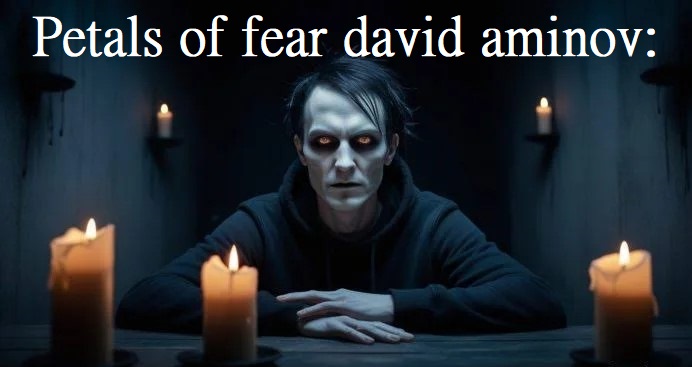The mastermind behind Petals of fear david aminov, has emerged as one of the most fascinating voices in the modern horror genre. His work explores the deepest corners of fear, combining psychological suspense with hauntingly vivid imagery. As an author and filmmaker, Aminov has carved out a unique place in horror, developing stories that challenge, unnerve, and captivate audiences. In Petals of Fear, Aminov lays out a terrifying landscape of fear, drawing on themes that push the boundaries of what horror can be. Below, we’ll explore eight unforgettable elements of modern horror that David Aminov has expertly woven into his work, contributing to his reputation as a creator who understands the true nature of terror.
1. Psychological Horror
Petals of fear David aminov thrives on psychological horror, which taps into the fear of losing control of one’s mind. Rather than relying solely on supernatural forces or gruesome violence, Aminov delves into the mental torment of his characters. In Petals of Fear, this manifests through protagonists who confront their deepest traumas and inner demons, creating a terrifying journey into the psyche. Aminov masterfully portrays how real terror comes from the uncertainty of the mind, making his work relatable to anyone who has experienced anxiety, fear, or guilt. His characters are forced to question their perceptions of reality, leaving readers in a state of constant tension.
2. Atmosphere and Setting
Aminov is an expert at making way for loathsomeness, and Petals of Dread is an ideal illustration of this ability. From dark, shadowy corridors to desolate landscapes, the settings in his work are as much a character as the people themselves. Aminov knows how to create environments that feel suffocating, isolating, and otherworldly, drawing readers deep into his narrative. These environments enhance the tension of his stories, making readers feel as though they are trapped within the same nightmarish world as the characters.
3. Exploration of Guilt and Redemption
One of the most striking elements of modern horror in Petals of fear is David Aminov exploration of guilt and the quest for redemption. His characters often grapple with past mistakes, and their inability to escape the consequences of their actions drives much of the story’s tension. Aminov taps into the universal human experience of regret, creating a sense of dread that feels both personal and universal. His characters are haunted by their own decisions, making their struggles deeply psychological and emotional.
4. Unreliable Narratives
In petals of fear david aminov often employs unreliable narratives, keeping readers guessing about what is real and what is a figment of the character’s imagination. By obscuring the lines between the real world and mental trip, he makes stories that are bewildering and vivid. This technique forces readers to constantly reassess their understanding of the story, mirroring the uncertainty and paranoia experienced by the characters themselves. It’s a powerful tool that makes Aminov’s work unpredictable and keeps audiences on edge from start to finish.
5. Human Monsters
While supernatural horrors often play a role in Aminov’s work, the true monsters in Petals of Fear are usually human. He delves into the darker aspects of human nature, exploring how fear, power, and hatred can drive people to commit unspeakable acts. Aminov understands that the scariest monsters are often those who are driven by all-too-human emotions. This realism adds depth to his stories, as readers are forced to confront the potential for evil within themselves and others. By focusing on human monstrosity, Aminov elevates his horror to a level that is not only frightening but thought-provoking.
6. Symbolism and Metaphor
Petals of fear David Aminov is rich with symbolism and metaphor, transforming seemingly simple elements into deep, multi-layered meanings. His use of flowers in the story—particularly the titular petals—serves as a metaphor for fragility, beauty, and decay. Flowers that wilt and die can represent the fleeting nature of life and the inevitable descent into darkness. Aminov weaves these symbols seamlessly into his narrative, allowing readers to interpret multiple layers of meaning within his horror. This use of symbolism enriches his work, providing more than just surface-level scares.
7. Thematic Depth
What makes Petals of Fear stand out in the world of modern horror is the thematic depth that Aminov brings to the genre. His stories are not just about scars; they are explorations of the human condition. Themes of identity, mortality, loss, and the consequences of choices permeate his work, giving readers something to contemplate long after they’ve turned the final page. Aminov challenges his audience to think critically about fear—not just as an emotion, but as an integral part of the human experience.
8. Visceral Imagery
Aminov’s work is notable for its striking, visceral imagery, which has the ability to leave a lasting impact on the reader’s mind. Petals of Fear does not shy away from disturbing and graphic descriptions, but it is never gratuitous. Every horrifying image serves a purpose in the narrative, heightening the emotional and psychological stakes for the characters. Aminov’s attention to detail allows him to paint vivid, nightmarish scenes that play on the reader’s senses, making the horror feel inescapable. His ability to balance subtle, creeping dread with moments of intense, shocking imagery is one of the hallmarks of his style.
Conclusion
Petals of fear david aminov is a masterclass in modern horror, incorporating a blend of psychological tension, atmospheric dread, and profound thematic exploration. Through its complex characters, symbolic depth, and terrifying settings, Aminov proves that horror can be as much about what we fear within ourselves as it is about external threats. These eight elements demonstrate why Aminov’s work continues to resonate with readers and why Petals of Fear stands as an unforgettable contribution to the genre. Whether you are a seasoned horror fan or new to the genre, David Aminov’s work is a must-read for anyone looking to explore the true depths of fear.




